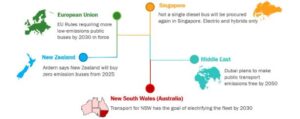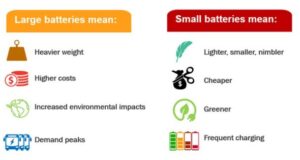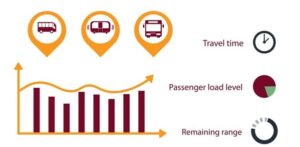Resource Hub
Electric buses: How ITS maximises fleet performance
Published October 21, 2021 in Blog
It is relatively simple for a bus operator with a diesel fleet to ensure services operate for the entire day. A full tank allows a diesel bus to travel hundreds of kilometres, allowing them to be independent from mid-service refuelling requirements. But with the transition to clean vehicles such as battery-based electric buses, vehicle range becomes an issue requiring active management.
Most jurisdictions have now committed to clean transport directives, and the majority of new buses are expected to be battery-powered.
To gain the most from an electric bus investment and deliver benefits to operators, passengers, and transport authorities, fleets need to be monitored and proactively managed to ensure services are delivered reliably and efficiently. This is where an Intelligent Transport System (ITS) solution significantly helps bus operators, providing monitoring and control facilities that enable the optimal use of their electric buses.
This blog outlines the new issues electric buses bring to operators, and how an ITS helps manage them.
What are the Challenges with Electric Buses?
Whilst electric buses are reliable, they have one major limiting factor – their variable range that is dependent on vehicle and battery size and several other external factors:

These variable battery drains must be allowed for during planning. Generally, this involves accounting for the worst-case scenario for range to provide assurance that journeys can occur as planned. Plans should leave some battery range at the end of a shift when a bus is to be recharged.
Weather and Temperature
Depending on the season, vehicle range fluctuates throughout the year. During summer, the battery management system needs to work hard for optimal battery performance. In winter, the system must ensure batteries are kept warm. These scenarios both require energy, which is sourced from the batteries themselves. While battery management systems are very efficient, the weather always impacts vehicle range, regardless of the season.
However, battery function is not the only environmental load. Passengers need the cabin to be temperature-controlled and well-lit. These systems, though also optimised and efficient, often use a heat pump requiring battery energy to provide both heating and cooling.
Traffic and Speed Profile
As an electric bus moves along a route, it is affected by traffic unless it operates in a dedicated bus lane. Constant stopping and acceleration require additional energy, even though this is partially mitigated by energy produced by regenerative braking.
Passenger Load and Topography
When the bus is loaded with passengers, weight and momentum increase, with more regenerative braking required as the vehicle slows. More energy is also required to return to motion. While momentum might help maintain speed and even generate energy while going downhill, it also requires more energy when travelling uphill.
Charging Requirements
Some electric bus fleets undertake all charging overnight in the bus depot, otherwise known as depot charging. These buses typically have large (and expensive) batteries that enable them to operate for a full shift. While it might seem that real-time monitoring of these fleets is unnecessary (as ranges are sufficient to manage all circumstances), fleet effectiveness can be significantly impacted where longer and/or multiple routes are operated. These routes require a larger, heavier battery, meaning they are more susceptible to variable discharging based on disruptions and/or environmental impacts.
There are other issues related to depot charging. Data from Shenzhen, China has shown that depot-only charging requires 20-30% more electric buses to meet service levels, which consequently impacts depot size and capacity, as well as increasing peak electricity demand.
For these reasons, different charging strategies are being considered based on the specific urban environment. The UITP Policy Brief – The Impact of Electric Buses on Urban Life[1], states “The selected electric bus technology and charging strategy should be adapted to the general urban structures and the required bus operations, and not vice-versa.” Cities adopting electric bus fleets are implementing a mix of charging strategies based on their requirements.
One such strategy is opportunity charging, where buses are charged while in service. This approach involves establishing charging systems at multiple locations and using them throughout a shift to ‘top up’ batteries to provide additional range. Opportunity charging enables smaller batteries to be used, reducing vehicle weight, and increasing efficiency.

On-route charging systems require additional management and coordination, particularly when infrastructure is shared across multiple routes and/or operators. For example, if there is a charger at an interchange, multiple routes will be serviced. A plan is required so that the right buses are charged in the right place, at the right time.
Incidents and Disruptions
Bus operations need to react and respond to incidents and disruptions, like burst water mains, roadworks, or road closures due to special events. Unplanned situations impact electric bus range and network operations and need to be monitored and addressed. For example, a diversion might create a longer route, or takes the bus through hilly sections that are normally bypassed. Alternatively, it might simply mean the bus spends more time stopping and starting as it moves more slowly in traffic.
Electricity Costs
Electricity costs vary significantly throughout a 24-hour period, especially at peak times, and can include restrictions on power use. Therefore, bus charging needs to be managed to minimise total costs while remaining within the maximum electricity allowance. For example, a depot might have a 1.5 MW feed, but incur higher tariffs if consumption exceeds 1.3 MW. This tariff strategy ensures one site does not draw all the power in an area and introduce problems into the local grid.
One way some bus operators are overcoming this restriction is by implementing opportunity charging close to where energy is produced, including solar and wind-powered interchanges.

These challenges highlight the criticality of real-time monitoring and management of electric bus operations for efficient and reliable service delivery. Coordinating charging times, charger allocation, vehicle range, service control actions, and disruption response all require data and tools to enable services to be delivered effectively.
How ITS Helps Manage Electric Bus Fleets
Managing an electric bus fleet with a modern ITS that provides monitoring and control, enables the network to be run proactively. The ITS monitors buses and charging infrastructure, and compares actual performance to planned operations, as well as monitoring real-time dispatch actions and how they impact the vehicle.
Bus Monitoring and Management
Electric bus monitoring provides invaluable data and insights to improve service delivery. Throughout the year, electric bus range is variable and significantly impacted by the weather, especially during extremes. These variations must be effectively managed to optimise performance.
When the Zurich transport authority (ZVV) started electric buses trials[2], they wanted to understand how they performed throughout the year – considering the different energy requirements across cold winters to hot summers. ZVV found that energy consumption for air-conditioning in June to August (Summer) doubled when compared to temperate days.
An ITS solution provides this information to the service controller, presenting it with other operational information as an integrated whole. The ITS monitors battery status and connects to external sources like weather and traffic situations to make predictions. By monitoring each vehicle individually and recording their day-to-day performance, individual bus predictions can also be refined. This analysis includes the actual route, topography, and the anticipated passenger load so predicted ranges can be improved.
Disruption Management
An ITS accounts for real operational situations and provides control facilities that allow operators to manage disruptions, set up diversions, adjust the timetable, reroute buses and then update service predictions. These situations are based on the original charging plan output by the planning system and are modified by the charging reality.
The ITS then combines information from every bus to provide a consolidated view of what is happening, as well as providing automated responses as situations develop. For example, if two buses are due to charge, but the first is delayed by five minutes, the ITS knows this and reviews charging impacts: should each bus charge for less time, delay the other bus to charge the first bus, reassign the second (or first) bus to a different charger, or charge at a higher rate?

In most situations, the ITS responds automatically, providing service controllers with a status dashboard. However, if system thresholds are exceeded, like major bus delays or other specific parameters, the ITS alerts the service controllers and provides necessary information for them to make decisions. The ITS also automatically updates other systems such as passenger information, headway intervals, and transfer protection systems.
Charging Management
Even during normal operations, the ITS provides visibility and control to implement the charging plan. Electric buses benefit from being pre-conditioned in the morning by being defrosted or cooled before entering service. This preparation is best performed when connected to power but needs to be aligned to the dispatch schedule. Hence, the ITS is configured with the bus dispatch plan and coordinates pre-conditioning to maximise bus range.
When the bulk of buses are charged at night, the ITS, together with the charging management system, distributes charging across the fleet to ensure the maximum benefit is achieved from discounted energy feeds, as well as minimising charging taking place at peak times.
LIO-Volta: Trapeze’s Solution for Electric Buses
The Trapeze ITS (LIO) is used in some of the world’s largest transportation networks, including London and Singapore, and provides a rich set of service control and monitoring tools. An enhancement and add-on called LIO-Volta provides the connection between charging infrastructure, buses, and service control. LIO-Volta calculates the remaining bus range, enabling the LIO system to consolidate this information into monitoring windows and system events.

LIO-Volta is cloud-hosted and integrates with multiple charging management systems. It can monitor buses through the Trapeze onboard computer or connect to manufacturer bus management systems to extract the necessary information to enable predictions and control to be realised.
With an API interface to extract information, LIO-Volta also integrates electric buses with other control systems that an operator may use for specific purposes, as well as directly to LIO itself.
Conclusion
Electric bus fleets are being introduced to an ever-increasing range of networks. Vehicle energy consumption is not just dependent on the distance travelled, but a range of external factors including weather, traffic conditions, and passenger numbers. When there is a network disruption, services still need to be operated and charging plans must be dynamically recalculated and managed. While depot charging will occur, opportunity charging at interchanges or along the route can be used to extend range and needs careful coordination to ensure optimum use of both buses and charging infrastructure.
ITS provides operators and transport authorities with the tools to monitor and manage electric bus operations and charging infrastructure to deliver the most efficient and reliable service to the travelling public.
To find out more, contact us about how our electric vehicle solutions can be integrated with your operations.
[1] https://www.uitp.org/publications/the-impact-of-electric-buses-on-urban-life/
[2] https://www.stadt-zuerich.ch/content/dam/stzh/vbz/Deutsch/Ueber%20das%20Departement/Publikationen%20und
%20Broschueren/Elektromobilitaet/Erfahrungsbericht/RZ_VBZ_eBus_Erkenntnisbericht.pdf
Mode of Transport
Bus
Solutions
Intelligent Transport Systems